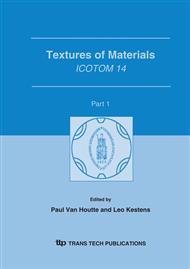p.143
p.149
p.157
p.167
p.173
p.179
p.185
p.191
p.197
An EBSD Analysis of the Origins of Ridging in AISI 430 Steel Sheets
Abstract:
In the present work the characterisation of both the microstructure and the microtexture of two ferritic stainless steel sheets - AISI 430 (Fe17% Cr) and AISI 434 (17% Cr, 1% Mo) - known to display different ridging behaviours, was carried out by optical metallography, EBSD and OIM techniques. It was concluded that severe ridging is a consequence of: (a) presence of {111}
Info:
Periodical:
Pages:
173-178
Citation:
Online since:
September 2005
Price:
Сopyright:
© 2005 Trans Tech Publications Ltd. All Rights Reserved
Share:
Citation:


